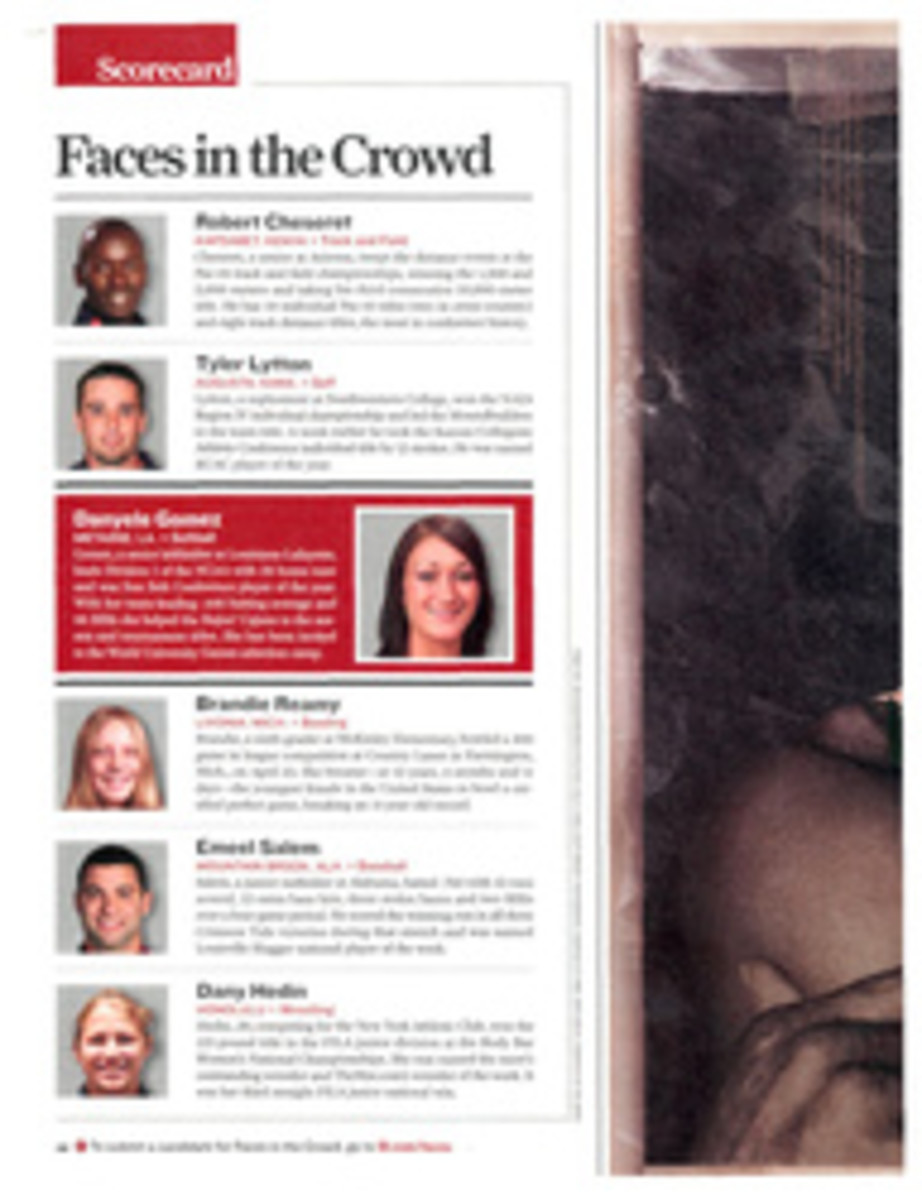
The Final Days
All through the1990s p.r. firms in Myrtle Beach, S.C., sent out a steady stream of birthannouncements--press releases trumpeting the grand openings of golf courses,the latest one nearly always grander than the last. Now, with much lessfanfare, comes something else: a wave of death notices. ¶ By the count of golfwriter Alan Blondin of the city's daily, The Sun News, in 2001 there were 120courses in and around Myrtle Beach, the epicenter of the middle-class golfboom. By the end of this year, Blondin estimates, the number will be down to107, and by 2010 he thinks the total will be 100. The golf-course owners on theGrand Strand find themselves where the East Hampton potato farmers on LongIsland found themselves 40 years ago--land-rich and cash-poor. When housingdevelopers come rooting around your maintenance shed, checkbook in hand, it'shard to say no. You own 150 acres of golf course in Myrtle Beach. You're making$100,000 a year from those acres, maybe double that in a monster year. The guywith the alligator belt and the checkbook is talking about $25 million for thewhole kit and caboodle. Beverly Hills, here we come.
Last week aMyrtle Beach p.r. firm sent out a press release under the headline MYRTLEBEACH, SOUTH CAROLINA, NAMED AS THE NUMBER ONE GOLF-HOME COMMUNITY IN THEUNITED STATES BY GOLF DIGEST.  It cited the Grand Strand's reasonable costof living, the plethora of courses, the good weather--the very things that madeentrepreneurs bullish on Myrtle Beach in the first place. But now, with manycourses having succumbed and a bunch more on life support, Myrtle's in a stateof flux. There will be more housing than ever and more golfers living there,but fewer holes to put them on. Golf architect Rees Jones, who has designedfive Grand Strand courses, has now seen three of them sold to developers. Thedeaths in his golf family were not those of ho-hum layouts. The sellouts arehappening wherever the land is worth more to the developers than the course isto the owners.
"It's hard towatch," Jones says. "You put two years of effort into building acourse, and then in a week a bulldozer obliterates what you've done. I went toone of the courses, Belle Terre, before the bulldozers came. Played it withstrangers. Didn't tell them who I was. Made a birdie on the last--a bittersweetexperience. An empty feeling."
On May 15 therewere three fatalities, the three courses of the Bay Tree Golf Plantation, inNorth Myrtle Beach. Closing day was like a wake for 54 holes, 55 if you countthe mellow clubhouse bar, with its plastic cups and sandwiches to go. Thecourses (the Green, Gold and Silver) were relics of the early '70s, designed byGeorge Fazio, the uncle of Tom, and built simultaneously for less than $1million. Four men founded Bay Tree, and three of them are dead. The survivor--aman known as the General--and 20 other shareholders voted to sell the 586-acrespread to a developer called Centex, which plans to build 1,400 houses on theproperty. The General, James F. Hackler on his driver's license, tried to talkthe Centex people into preserving one of the 18s, preferably the one that oldBay Treers call the Green Monster, home of the 1975 PGA Tour Q school attendedby Bruce Lietzke, Calvin Peete, Tom Purtzer and many players you most likelyhaven't heard of. But Centex had no room in its heart, or in itsphone-book-thick business plan, for a golf course. The purchase price was $20million.
The greens fee atthe end was $34, walking or riding, and everybody rode at Bay Tree. You'd seepeppy carts bouncing along macadam paths, veiny with cracks from heat waves andswelling tree roots. Two 20 handicappers, Maggie Collins and Barbara Mullins,came out for the final day. The course was in nice condition. Not superspectacular TifEagle-Bermuda-hybrid-bent-USGA specs-on-steroids condition.Simply regular nice--green grass, firm earth underneath, same as it ever was.The Bay Tree courses were home to hundreds of black squirrels so at ease withthe golfers that they acted like pets; one of their number sneaked intoCollins's purse and stole her lunch. The girls (ladies of a certain age likethat description) were undaunted. They intended to play only 18 on closing daybut ended up playing 54, and they were the last golfers standing on thatwistful Monday. Mullins had three rounds of 94, Collins three rounds of 90.Five-hundred and fifty-two shots and one lost ball. Beat that.
The Bay Treefairways are--correction, were--flat as grits. The rough was nothing but ablanket of pine needles. The bunkers--correction, traps--had sand in them. Youweren't going to power a putt off the green, and you didn't have to go twoexits on the turnpike to get to the next tee. Bay Tree was unpretentious,affordable golf, played at a decent pace, the kind you see all over the Midwestand Texas and Canada. But when vacationing golfers, platinum cards in theirwallets, go on vacation these days (to Orlando, to Las Vegas, to Scottsdale,even to Myrtle), they don't want unpretentious, affordable, fast golf. They'relooking for spiffy. Five-hour rounds and $200 greens fees have become part ofthe cultural (golf division) expectation of excellence. It's a sucker'sgame.
Back in the day,when Evel Knievel--"world known daredevil," so described in a yellowingclip on a clubhouse wall--played the Green Monster, Bay Tree was spiffy. Once,anybody looking for action on the Strand came to Bay Tree, and there were gamesplayed for $200,000 a side, or more, in a state where even the $2 Nassauviolates its gambling laws. Leonard Thompson, winner of the 1974 Jackie GleasonInverrary Classic, represented Bay Tree on Tour in its early years. "BayTree didn't have hustlers," Thompson says. "It had gamblers." Thethree deceased founders, Howard Anderson, Brian Floyd and Ed Martin, wereThompson's backers when he first went on Tour in '71. You don't hear much aboutbackers anymore. In the era of corporate golf, the equipment manufacturers arethe backers. The Bay Tree founders were businessmen who liked being aroundgolf.
By the end,visiting Bay Tree was like entering the Twilight Zone. General Hackler--WestPoint, World War II, once close to scratch, silver-haired and unstooped at85--was at the course every day, the boss right to the end. Robert Riggins, ason of the South who spent 23 loyal years at Bay Tree, was the club'sall-purpose groundsman and greeter, grabbing bags from arriving cars andgetting them on carts. He made enough money at Bay Tree to buy a car and a lotfor a trailer, a living wage and more. "I made more friends here than Iever thought imaginable," he says. In recent weeks Tracy Conner, Bay Tree'slongtime general manager, has made calls for Riggins and many of the club'sother 59 employees, helping them land jobs on courses elsewhere on the Strand.Everyone has something lined up, except the 40-year-old Conner. He's stilllooking at a few months of wrap-up work. When he's done, he wants to "slipaway into that good night," he says. Etched in his mind is the tree thatgrew out of the pond in front of the 13th green on the Green, the people heworked with and the music.
Along theperimeter of the clubhouse, in the staging area and up and down the drivingrange, you'd hear a Myrtle Beach oldies station playing Peter Frampton, BobSeger and Lynyrd Skynrd. It was Bay Tree's way of drowning out the arrivalnoise and telling the paying customers what they already knew: They weren't atAugusta National, or even the Dunes, the most Brahmin of the Grand Strandcourses.
That was theappeal and the problem. As the new Myrtle courses got fancier and moreexpensive, ambitious Strand golf tourists, looking to take home stories, nottidy scorecards with no X's on them, didn't want to come all that way to playBay Tree's plain-Jane courses. The number of rounds played on the three coursesdidn't change substantially over the decades: Most years Bay Tree yieldedbetween 110,000 and 120,000 rounds. In 1997 the three courses stood up to128,000 rounds, the most played in Bay Tree's 34-year history. Hackler saidthat business slowed substantially after the 9/11 attacks. In 2002 Bay Tree hada poor year, with slightly more than 100,000 rounds played, and a lot of thegolfers were locals, or visitors from nearby North Carolina. In 2000 Bay Tree'saverage greens fee was $50. By last year it was $35.
"The hotelssend the golfers out," says Jones. He has been visiting Myrtle Beach allhis life. "You hear guys on the plane saying, 'Where are we going to play,Joe?' Joe says, 'I don't know. The hotel set it up.'" The golf guys at thehotels know that most people don't come all the way to Myrtle to play courseslike the ones they can play at home.
In its own wayBay Tree was a trip. In the clubhouse, with its burnt-orange retro-chiccarpeting, there were reminders that Bay Tree was one of the original 36courses on the Golf Card, if you remember that discount voucher fromyesteryear. There's a picture of Jack Nicklaus playing in a 1983 fund-raiserfor Jack Newton, the Australian golfer who lost an arm to a helicopter blade.There was a collection of ties from golf clubs and an equipment collectionfeaturing the jigger, a long-dead utility club. Real golf permeated the place.On the course you could buy a six-pack and a bag of ice for $15. In thevisitors' register in the pro shop, a golfer wrote, "Nice course. Sorryit's closing."
"We've hadsome big events," Hackler said, with the end coming. "We had the Qschool, the seniors, the Hooters tour, the LPGA. Rotary had an internationalevent here. In 1974, with the gas crisis, I didn't think we were going to makeit. We couldn't pay our bills. Now I'm getting a check."
Hackler believedin marketing tests. On each scorecard was a short survey. If you filled it out,you got a 10% discount in the pro shop. One of the questions was, "Did youhave a pleasant experience?" The answer, 98% of the time, was yes.
PHOTO
Michael Bamberger
 GOLDCOAST
Megahouses are sprouting up on the Intracoastal Waterway and elsewhere inMyrtle Beach.
PHOTO
Michael Bamberger
 BLUEMONDAY
May 15 was a sad day for regulars who played Bay Tree one lasttime.
THREE PHOTOS
Michael Bamberger
 PERSONAL TOUCH
Conner (above right, tan slacks), Riggins (inset) and Hackler (striped shirt)were Bay Tree fixtures.
THREE PHOTOS
Michael Bamberger
 TAPS
After Collins (above, far right) and Mullins played 54 to celebrate Bay Tree's34 years, the flags came down for good.

